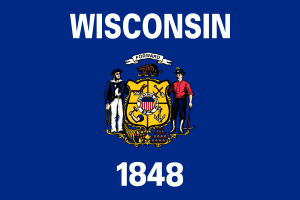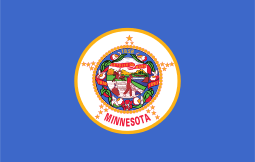La Crescent, Minnesota
| La Crescent, Minnesota | |
|---|---|
| City | |
| Nickname(s): "Apple Capital of Minnesota" | |
 Location of La Crescent within Houston and Winona Counties in the state of Minnesota | |
| Coordinates: 43°49′36″N 91°18′18″W / 43.82667°N 91.30500°W | |
| Country | United States |
| State | Minnesota |
| Counties | Houston, Winona |
| Government | |
| • Type | Mayor – Council |
| • Mayor | Mike Poellinger |
| Area[1] | |
| • Total | 3.47 sq mi (8.99 km2) |
| • Land | 2.94 sq mi (7.61 km2) |
| • Water | 0.53 sq mi (1.37 km2) |
| Elevation | 679 ft (207 m) |
| Population (2010)[2] | |
| • Total | 4,830 |
| • Estimate (2015[3]) | 5,074 |
| • Density | 1,642.9/sq mi (634.3/km2) |
| Time zone | Central (CST) (UTC-6) |
| • Summer (DST) | CDT (UTC-5) |
| ZIP code | 55947 |
| Area code(s) | 507 |
| FIPS code | 27-33866[4] |
| GNIS feature ID | 0646292[5] |
La Crescent is a city in Houston and Winona counties in the U.S. state of Minnesota. The population was 4,830 at the 2010 census.[6]
Most of La Crescent is located within Houston County with only a small portion in Winona County. La Crescent is known as the "Apple Capital of Minnesota" because John S. Harris planted the first apple trees in the midwest here and there are many orchards located near the city.
History
Sitting on the banks of the Mississippi River, La Crescent, Minnesota is surrounded by beautiful bluffs with spectacular views of the river. Humans have inhabited this area, which is abundant with wildlife, for thousands of years. The most recent inhabitants before the arrival of white settlers were the Dakota Indians, who were a branch of the Sioux, and the Winnebago.
Following the 1803 Louisiana Purchase, Nathan Boone, youngest son of Daniel Boone was among the early surveyors of this area. The various Indian tribes who had lived here were relocated in the 1840s to accommodate white settlement.
La Crescent was founded in 1851 by Peter Cameron and was originally called "Camerons". Peter and his wife, Emma, were two of the town's most colorful characters. Peter tried to dig a canal to change the flow of the Mississippi River so it would flow closer to La Crescent and bypass La Crosse, Wisconsin across the river. He died 10 weeks before its scheduled completion in 1857, and the canal was never finished, although the canal can still be seen in aerial photographs of the city. The Presbyterian missionary Sheldon Jackson lived in La Crescent prior to 1872, when he moved westward to Denver and later Alaska.
The second name of La Crescent was "Manton", named by William and Harvey Gillett, after they cleared the downtown area for settlement for Peter Cameron. In quick succession, the name of the town was changed again by the somewhat unscrupulous Kentucky Land Company, which was a land speculation company. They wanted a more romantic-sounding name for the town to attract settlers and came up with "La Crescent", after the bend or "crescent" shape of the Mississippi River around the town. La Crescent incorporated in 1857.
John S. Harris arrived in La Crescent in 1856 and soon gave the town its identity of "Apple Capital of Minnesota", a title that the city copyrighted in 2002. Despite the belief "by 99 out of 100” people that apples could not grow in Minnesota", Harris planted his first apple trees here in 1857 and experimented with them until he grew trees hardy enough to withstand the severe Minnesota winters. He planted thousands of apple trees and hundreds of varieties, a full half of which he said were complete and total failures. Harris became known as "Father of the Orchardists" in Minnesota and was also a founding member of the Minnesota State Horticultural Society. Since 1948 La Crescent has celebrated this apple heritage annually with a weekend festival known as Applefest.
La Crescent has entertained a number of businesses throughout its history, but the one that has endured the longest is the apple industry. Around the 1940s La Crescent had about 40 small orchards in and around the city. Although the number of orchards has dwindled to less than a dozen, the area is about the same, as the orchards have been expanded in the bluffs farther away from the city. La Crescent grows gourmet apple varieties not found in most other places. Eighty percent of its apples are sold in Minnesota, although they are also exported to surrounding states and Canada.
There are markets in La Crescent which sell honey and other organic products, as well as apples. There are many outdoor activities to do in the area, such as biking, hiking, fishing, bird watching, skiing, snowmobiling, and fourwheeling.
Geography
According to the United States Census Bureau, the city has a total area of 3.47 square miles (8.99 km2); 2.94 square miles (7.61 km2) is land and 0.53 square miles (1.37 km2) is water.[1]
La Crescent sits 3 miles across the Mississippi River from Onalaska, Wisconsin and the northern part of La Crosse, Wisconsin. Winona, Minnesota is 21 miles to the north of La Crescent. It is the largest city in Houston County and the second largest in Winona County.
Bluffs
La Crescent is known for having many bluffs compared to other cities in Minnesota. The city is situated on the side of a large bluff, with other large hills within the city. Since La Crescent is below the normal level of the rest of the area, the bluffside shields it from some of the harsh winds and tornadoes that other areas on consistently flat ground experience.
Demographics
| Historical population | |||
|---|---|---|---|
| Census | Pop. | %± | |
| 1870 | 380 | — | |
| 1880 | 326 | −14.2% | |
| 1910 | 372 | — | |
| 1920 | 373 | 0.3% | |
| 1930 | 520 | 39.4% | |
| 1940 | 815 | 56.7% | |
| 1950 | 1,229 | 50.8% | |
| 1960 | 2,624 | 113.5% | |
| 1970 | 3,296 | 25.6% | |
| 1980 | 3,674 | 11.5% | |
| 1990 | 4,311 | 17.3% | |
| 2000 | 4,923 | 14.2% | |
| 2010 | 4,830 | −1.9% | |
| Est. 2015 | 4,826 | [7] | −0.1% |
| U.S. Decennial Census | |||
2010 census
As of the census[2] of 2010, there were 4,830 people, 2,012 households, and 1,370 families residing in the city. The population density was 1,642.9 inhabitants per square mile (634.3/km2). There were 2,126 housing units at an average density of 723.1 per square mile (279.2/km2). The racial makeup of the city was 96.5% White, 0.8% African American, 0.1% Native American, 0.6% Asian, 0.1% from other races, and 1.8% from two or more races. Hispanic or Latino of any race were 1.1% of the population.
There were 2,012 households of which 30.7% had children under the age of 18 living with them, 55.2% were married couples living together, 10.0% had a female householder with no husband present, 2.9% had a male householder with no wife present, and 31.9% were non-families. 27.1% of all households were made up of individuals and 12% had someone living alone who was 65 years of age or older. The average household size was 2.37 and the average family size was 2.86.
The median age in the city was 42.8 years. 23.5% of residents were under the age of 18; 6.8% were between the ages of 18 and 24; 22.7% were from 25 to 44; 30.4% were from 45 to 64; and 16.6% were 65 years of age or older. The gender makeup of the city was 47.7% male and 52.3% female.
2000 census
As of the census[4] of 2000, there were 4,923 people, 1,940 households, and 1,367 families residing in the city. The population density was 1,634.4 people per square mile (631.5/km²). There were 2,014 housing units at an average density of 668.6 per square mile (258.3/km²). The racial makeup of the city was 97.60% White, 0.43% African American, 0.08% Native American, 0.87% Asian, 0.08% from other races, and 0.93% from two or more races. Hispanic or Latino of any race were 0.73% of the population.
There were 1,940 households out of which 35.0% had children under the age of 18 living with them, 59.1% were married couples living together, 8.8% had a female householder with no husband present, and 29.5% were non-families. 26.0% of all households were made up of individuals and 11.3% had someone living alone who was 65 years of age or older. The average household size was 2.49 and the average family size was 3.02.
In the city the population was spread out with 27.3% under the age of 18, 7.1% from 18 to 24, 28.6% from 25 to 44, 21.2% from 45 to 64, and 15.8% who were 65 years of age or older. The median age was 38 years. For every 100 females there were 92.9 males. For every 100 females age 18 and over, there were 89.1 males.
The median income for a household in the city was $45,433, and the median income for a family was $54,708. Males had a median income of $40,316 versus $24,308 for females. The per capita income for the city was $21,361. About 0.8% of families and 3.9% of the population were below the poverty line, including 1.9% of those under age 18 and 12.8% of those age 65 or over.
Education
The La Crescent–Hokah Public Schools is the city's public school district, and Kevin Cardille is the superintendent. It includes La Crescent–Hokah Elementary School and La Crescent–Hokah Middle/High School. Other educational opportunities include the Crucifixion Catholic Elementary and La Crescent Montessori Academy & STEM schools.
Recent notable people
- Eriah Hayes, Hockey player.
- Connor Franta, Entrepreneur, writer and YouTuber.
Infrastructure
Transportation
U.S. Highways 14 and 61; and Minnesota State Highway 16 serve as main routes in the community. The northern edge of La Crescent is skirted by Interstate 90 and I-90 Mississippi River Bridge.
References
- 1 2 "US Gazetteer files 2010". United States Census Bureau. Retrieved 2012-11-13.
- 1 2 "American FactFinder". United States Census Bureau. Retrieved 2012-11-13.
- ↑ Stotts, Ryan. "La Crescent population above 5,000". Houston County New. Retrieved 22 February 2016.
- 1 2 "American FactFinder". United States Census Bureau. Retrieved 2008-01-31.
- ↑ "US Board on Geographic Names". United States Geological Survey. 2007-10-25. Retrieved 2008-01-31.
- ↑ "2010 Census Redistricting Data (Public Law 94-171) Summary File". American FactFinder. United States Census Bureau. Retrieved 27 April 2011.
- ↑ "Annual Estimates of the Resident Population for Incorporated Places: April 1, 2010 to July 1, 2015". Retrieved July 2, 2016.
External links
- City of La Crescent
- La Crescent-Hokah School District
- La Crescent Crucifixion Elementary School
- La Crescent Montessori Academy & STEM School
- Houston County News
- La Crescent Apple Festival
- La Crescent Reddit Page



